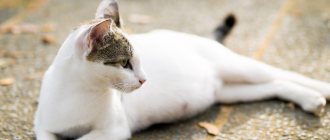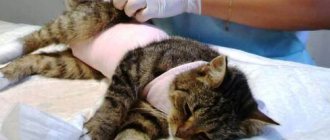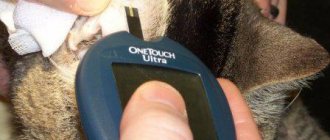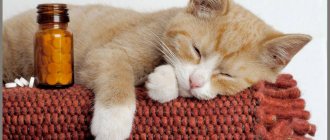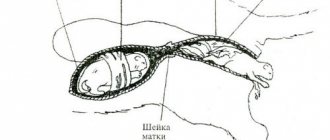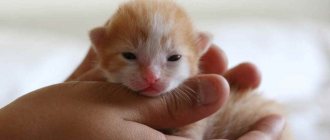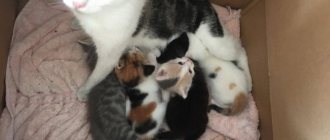It’s quite easy to teach a kitten to eat milk from your finger, but it’s too early to rejoice.
You are not going to feed your pet exclusively by hand in the future. So you will have to think about how to teach the kitten to eat on its own. Following the cat's laziness, you only make things worse for your pet. Again, pour the milk into the saucer and poke the furry muzzle into it. The little sly one may actively refuse to lap. Why should he, if a kind owner brings him food on his finger directly into his mouth? And here you need to be firm. If he refuses to lap, it means he’s not that hungry. Dip his nose into the saucer a few more times. If he wants, he will eat. Just don't overdo it. There is no way to force a kitten to eat on its own. More precisely, it will eat, but most likely it will no longer fit into the bowl. And you will find the remains of his meal anywhere.
How to do this, watch the video:
If you have a small pet in your home who was left without a mother early, you will have to take responsibility for teaching him basic skills yourself. The time when kittens begin to eat themselves may vary. Most often this is between 1 and 1.5 months from birth, when the baby has learned to walk independently. Your task is to help him master this science and feed him correctly.
Rules for feeding newborn kittens
Teaching a kitten to eat and drink from a bowl is a responsible task for the owner, since a newborn baby, left without a mother and her milk, needs special care and provision of comfortable living conditions.
If such a situation arises, then consultation with a veterinarian is necessary. In this case, newborn kittens are fed from a pipette, and the initial dosage of milk should not exceed more than 2 ml, since they have very small ventricles.
You can teach a kitten to eat from a bowl after three weeks of age, since motor reflexes have formed and he is ready to eat on his own.
Instructions for feeding and introducing complementary foods to newborn kittens:
- after birth, the kitten eats only mother’s milk for the first three weeks (a syringe, pipette with cow’s or goat’s milk is used as a replacement);
- in the period from three weeks to two months, a variety of foods (meat, fish, cereals, legumes) can be introduced into the baby’s diet;
- after four weeks of life, the kitten can be given porridge and pureed vegetables;
- at two months the kitten is ready to eat solid food (bones, cottage cheese, other unground foods);
- after three months, a mature kitten can eat bones, sinews, raw meat, chopped vegetables and fruits;
- After five months, the kitten is ready to eat food that adults eat.
How to train a kitten to eat on its own
In order to teach a kitten to eat from a bowl on its own, you need to make an effort, depending on whether the baby is growing up with or without its mother.
A mother cat teaches her child to eat adult food, check its temperature, she shows him how to swallow food, break it up correctly, and with her purring invites him to a meal.
If the baby grows up without a mother, then the owner needs to teach the kitten to eat independently. In this case, the most effective method is considered to be giving a personal example (showing the baby how to lap milk from a saucer).
An effective method is to smear food on your finger or pacifier. The kitten, in turn, will lick it off and gradually understand that this is how it needs to be eaten to satisfy its needs.
Before a kitten learns to lap from a saucer, it is important to accompany each meal with the phrase “let’s go eat,” since the animal will form a clear reflex to this phrase in the future.
At the same time, obtaining the expected result, when the kitten, having heard the phrase, immediately approaches the bowl, takes time (at least 2 months of daily training).
Why might a kitten refuse to eat?
Sometimes the kitten refuses to eat on its own. This may happen because you started training him too early. In this case, it is better to return to feeding from a pipette or with the help of a cat. After some time, you can return to the science of independent nutrition.
The baby will not be able to start feeding on his own if the bowl is too uncomfortable. It may be large or slip on the floor covering. Buy him a bowl that fits his size.
and be stable on the floor. Then the small animal will feel comfortable and will be more willing to eat.
Your baby may not like food if it is too hot or cold. It is better to feed him food at room temperature. In addition, the animal may have health problems that prevent it from being able to feed itself. At the first sign indicating this, contact your veterinarian.
Why doesn't it work right away?
Many people wonder why it is not immediately possible to teach a kitten to feed from a bowl on its own and should understand that a small kitten that finds itself in a new family takes a longer time to adapt and needs additional care.
In order for the process of accustoming to food to move much faster, you need to diversify your baby’s diet as much as possible. As a result, his taste characteristics will be formed, and he will begin to eagerly eat from the bowl.
During feeding, the presence of the owner is important, since in such conditions the kitten feels comfortable and eats its portion to the end.
A few more rules...
There are quite a lot of opinions about what is best for a small pet and how to start teaching it to feed itself. But there are rules that need to be taken into account in any case:
- The bowl should be clean and convenient.
- There should always be water near food.
- Feed the animal according to its age and needs. If necessary, you can give him vitamins. But before that, consult your veterinarian.
- If your baby goes to the toilet regularly, then he has enough food.
- Don't force anyone to eat.
- Do not mix dry food and natural food (except when switching from one food to another is necessary).
- After eating, you can massage your pet’s tummy to start the mechanism of digesting unusual food.
- A clear separation between playing and feeding areas is necessary.
Following these rules will help your pet develop normally and grow up healthy. Teaching a kitten to feed itself is not always easy.
You must be patient with this process and notice all the changes that occur to him. This will help you plan your diet correctly and introduce new foods to the menu in a timely manner.
If something doesn't work out for you, you can always contact your veterinarian. He will tell you when the animal is ready to feed on its own and help you choose exactly the food that will saturate its body with the necessary vitamins.
Kittens are born small and completely weak, and at first all problems fall on the shoulders of the mother cat, but after three weeks she needs the help of her owner in order to cope with these little fidgets.
Three weeks after birth, babies begin to move, they already see, hear, and go to the toilet on their own.
Now the owner will have more troubles associated with caring for these wonderful creatures. In addition to the question of how to save a little fidget, a person will have another question: how and how soon to start teaching a cat to eat without help
others. This article talks about how to teach a kitten to eat on its own, and how to change its diet.
If a pet that has just been born is left without the care of its mother cat, then the owner will need a lot of time, patience and labor in order to put the weak baby on his feet. Naturally, his main assistant will be a veterinarian
, he will undoubtedly help you decide which type of food is most suitable for your pet, explain how to use cow’s milk instead of cat’s milk, and tell you how to teach a kitten to eat on its own.
How to quickly train a kitten to eat from a bowl
You can teach a kitten to eat from a bowl, if it is artificial, quite quickly using simple techniques:
- a kitten under 2 months of age does not think very well, so in order for him to understand that there is tasty food in the bowl for him, you need to smear his mouth with the mixture or unobtrusively lower his head into the bowl;
- The feeding bowl should not slide on the floor, and a container of water must be placed next to it. It is better to carry out the procedure at the same time, as the animal quickly gets used to the established routine;
- when feeding, do not exceed the servings of food, as in this case the baby’s feeding schedule may be disrupted;
- if the kitten is hungry, then it constantly squeaks, meows and looks for food in a bowl or in various corners of the apartment.
How to change a kitten's diet
A variety of diet is provided gradually after the first three weeks of a kitten’s life, which helps improve the functioning of the digestive system, and the baby begins to enjoy eating food.
List of approved products for small kittens:
- low-fat kefir aged three days;
- smoked meats can be used as a flavoring additive to food to develop a stable reflex to food intake in an animal;
- liquid porridges, vegetable purees;
- boiled meat in small pieces.
If more than 5 months have passed since the birth of the kitten, then it can eat a variety of foods in normal quantities, like an adult animal. Mature individuals have well-developed digestion, teeth have formed, so they are completely ready for adult life.
How to feed a newborn baby
An important aspect is to ensure the correct feeding schedule for newborn kittens who are left without a mother. In such cases, it is necessary to follow simple recommendations:
- It is convenient to feed a kitten with cow's milk from a pipette up to 8 times a day (the temperature of the mixture should not exceed 37 degrees). The temperature is checked by pouring a drop of milk onto the back of the hand;
- if the kitten has reached the age of 1 month, then for feeding you can use a regular bottle with a nipple;
- After each feeding of the newborn, it is recommended to massage the tummy to improve digestion (light strokes clockwise);
- A qualified veterinarian can create an individual diet that will help quickly establish the baby’s digestive process.
Age aspects of the cat “table”
Now we will look at how soon kittens begin to eat on their own. Until the kittens are at least a month old, they need to be fed 8 times a day
. The milk should be low-fat and slightly warmed; it must first be heated to approximately 37 degrees. To check the temperature, you need to drop milk on the outside of your palm. Until the kitten reaches two weeks of age, it is more comfortable to feed it from a pipette.
When the cat is three weeks old, you can try switching to a bottle with a nipple. After the baby has eaten, a simple abdominal massage is performed. This is necessary for the digestive system to function properly. When the pet is 1-1.5 months old, it must receive liquid food 5-6 times a day. The baby is allowed to give the following foods:
- children's meat and vegetable nutrition;
- semolina without sugar;
- boiled yolk;
- low-fat cottage cheese.
When your pet is 2 months old and the first baby teeth have begun to grow, you are allowed to start giving your baby solid food. However, at the same time, you should not exclude liquid food, because it is very beneficial for the kitten’s digestive system. It is important to remember that the kitten develops quickly, increases in size, and every day its need for nutrients also increases. The better a baby eats at a given age, the stronger his health will be as a result. By 2 months it is allowed to start giving the following products:
- lean boiled meat;
- cottage cheese;
- cereals;
- chicken yolk;
- milk and dairy products;
- natural yogurt.
To prevent the kitten from becoming wayward in the future, it is necessary to accustom it to the correct table when the kittens begin to eat themselves. It is not uncommon for cats to begin to eat only a certain type of food and refuse the rest - no less necessary. One regular meal cannot contain all the vitamins and nutrients suitable for a cat. And if you want your pet to be unpretentious in food, teach him cereals, fruits and vegetables from early childhood.
Now we come to the most basic question: how quickly and how to teach a baby to eat without the help of others and how long it will take.
As mentioned earlier, kittens become interested in eating on their own at three weeks of age, or rather, they show curiosity about the food of adult cats.
Therefore, this particular age is considered one of the best for teaching a baby to eat from a saucer.
First you need to pour warm milk into a saucer, just a little. Then dip your own finger and let your baby lick it. When the kitten understands that it’s tasty, you need to put the baby near the plate and dip his face directly into the milk. At first he will back away, but when he starts licking himself, he will remember the taste of the milk that was previously given to him on his finger.
At first, the kitten will snort and sneeze without stopping, releasing funny bubbles from the milk. This happens due to the fact that he is just mastering the technique of lapping, because not so long ago he had not had the opportunity to do this - he simply sucked milk from the breast of a mother cat. In addition, from time to time you can see that he himself climbs into the bowl with his feet, and these attempts must be stopped immediately.
To do this, simply remove it from the bowl, wipe its paws with a napkin and place the kitten next to the saucer. When he starts to climb into the bowl again, hold him back a little. This way you can teach your pet that his paws should never be in food.
Why might a kitten refuse food?
From time to time the pet refuses to eat on its own. This may happen because you started teaching him to eat on his own too early. In this case, it is better to start feeding the kitten with a pipette again or return it to the cat. After some time, you can again try to teach the kitten to eat on its own.
The kitten will not be able to start eating without the help of others if the bowl is very large or unstable, since the kitten will simply be uncomfortable. Buy him a bowl that fits his size and is stable on the floor. Then the little animal will begin to feel comfortable and will be more willing to eat.
The kitten may not like the food if it is very hot or cold
.
The kitten should be fed food that is not very hot, preferably at room temperature. Moreover, the baby may have problems with well-being. Because of these problems, the kitten will not be able to feed on its own. If you notice the first signs that indicate this, it is better to immediately contact your veterinarian
.
Some rules to help you in this matter
There are quite a few opinions about what is best for a kitten and how to start teaching it to feed itself
. However, there are rules that must be followed:
- The saucer should always be clean and suitable for a small kitten.
- There should be a bowl of water next to the food bowl.
- Feed your kitten according to its age and needs. If required, with the permission of the veterinarian, you can give your baby vitamins.
- If your baby goes to the toilet often, it means he has enough food.
- Do not force your baby to eat.
- Do not mix dry food and natural food (except in cases where a transition from one food to another is necessary).
- After your pet has eaten, you can massage its belly so that the digestive system starts working.
- There needs to be a clear separation between the playing and eating areas.
A little persistence and understanding, and within a week your little pet will learn to eat without help
others.
And it’s no longer so important when you teach your pet to eat from a bowl, the main thing here is patience. You just need to give him time to get used to food, different from his mother’s milk. And the most important thing: no need to worry too much. There are no cats that would prefer to eat only milk all their lives. Over time, your pet will stop being mischievous
and start trying new things.
It might be useful to read:
- How to properly prepare lamb shoulder baked in the oven;
- Potatoes baked in bacon strips;
- Jellied pike perch: recipe, cooking features;
- Mullet baked in the oven with potatoes;
- Very tasty stewed Chinese cabbage;
- Roll for tea in 5 minutes. Biscuit roll. Proper serving of homemade delicacies for tea;
- Ginger tea with honey and lemon benefits and harms;
- Stewed potatoes in a pressure cooker;
Recommendations for training a kitten yourself
Most often, problems with independent feeding in a kitten arise if it is separated from its mother at an early age, since it is she who teaches her offspring to lap from a bowl without problems and in a fairly short time.
If such nuances arise, experts give some recommendations:
- Bowl feeding begins with cow's milk, which is served warm. It is necessary to offer the kitten food and let it smell it. If he is not interested, then you can lightly poke him with his muzzle to fully experience the taste of the product;
- in some cases, the food bowl is not suitable in height, so it is best to purchase it from a special pet store in accordance with the appropriate parameters;
- after the kitten has learned to lap up milk from a bowl, you can gradually switch it to semolina porridge;
- Meat pate for kids is often tried as a new product that can be used during training. At the same time, the reaction to it is ambiguous (some kittens immediately try and eat the product, while others refuse food until they grow up);
- When eating, the kitten must also be given water, since the animal requires mandatory fluid intake, especially after a meal;
- in many cases, small pets love to bathe in a bowl of milk. At the same time, there is no need to limit such actions, since over time, kittens learn to eat well on their own;
- A kitten's normal nutrition can be assessed by the number of trips to the litter box. If they are regular, it means that the pet is well fed, and its digestive system is working stably.
How to raise kittens correctly
The eighth, ninth, tenth, etc. appeared in your house. wonders of the world - kittens . How to raise them correctly so that boys are real gentlemen and girls are noble maidens?
First of all, you need to take care of their mother: feed her carefully, constantly pet her and allow her to do everything except destroy the apartment or house. Then she will “gladly” give birth to beautiful and healthy kittens for you, and will always wash them, feed them and take care of them. The kittens are almost a month old, they already want to jump, run and have fun. If you have them in a certain fenced area, then you can start releasing them “into the wild”, let them run around the house.
But you need to carefully monitor them - at such a young age they can’t even really stand on their paws, but they jump wherever they want.
At the age of one month and 1-2 weeks, when the kittens have turned into fluffy “nuclear” lumps, they need to be taught to use the toilet and drink milk. This must be done very carefully, since kittens remember their first experience for almost their entire lives.
How to toilet train a kitten?
There are a large number of different ways of teaching, but the most effective is with paper. It could be a piece of newspaper, or toilet paper, any kind. It needs to be placed on the future litter box for kittens, then place this litter box in a visible place, where kittens usually jump, run and have fun. These “predators” like to do everything on something comfortable, and also relieve themselves. And so, one of them wanted to go to the toilet and sees that there is paper lying nearby, he runs up to it, stands in the toilet, on this paper and relieves himself. Then, this paper needs to be left for a while so that the smell is absorbed into the toilet. Over the next 1-2 weeks, repeat this “mechanism” with paper several times, and then the kittens themselves will understand where their toilet is.
How to teach kittens to drink milk?
If anyone thinks that this is as easy as shelling pears, then they are deeply mistaken. First you need good boiled milk, not hot or cold, something in between. Pour the milk into small bowls, it is very convenient to pour it into lids from different cans, liter, 2 liter, etc.
It is advisable to train kittens with someone, rather than alone. Take one fluffy and gently poke him into a bowl of milk, he will lick his lips. If the kitten is a prodigy, then he will immediately start drinking milk on his own, without your help. But most often, it is very difficult to teach kittens to drink milk. You need to “poke” their nose into the bowl several times every day.
How to teach a kitten to eat solid food on its own
In some cases, problems may arise when introducing solid food into a kitten’s diet, so you need to follow these simple rules:
- You can try placing small pieces of food directly into the kitten’s mouth. This way he will taste the product and subsequently will not refuse it, but will eat it with pleasure;
- As an initial complementary food, you can use dry food, which is pre-soaked in water. The initial quantity should not exceed 2 pieces;
- When introducing solid foods, you need to pay attention to the baby’s taste preferences (some kittens love cottage cheese, while others are delighted with fish). Based on the information received, a daily diet is compiled;
- It is recommended to start introducing solid foods with liquid porridges (semolina or crushed corn grits are considered the best option);
- dry forms are given to small kittens only after all their teeth have formed.
Kittens begin to eat on their own when they reach the age of 1–1.5 months. Before this time comes, you should try to teach your pet to drink milk and gradually diversify its diet by introducing other products.
What to feed a kitten?
Just feeding a kitten milk is not enough. He must receive from food all the necessary microelements and vitamins for normal development. When your baby is ready to eat on his own, his diet should look like this:
- Liquid porridge with milk (semolina, ground buckwheat).
- Dairy products.
- Boiled chicken or turkey, cut into small pieces.
- Thin slices of meat, processed with boiling water.
- Small pieces of boiled fish. The seeds are first removed.
The kitten should not be given fatty meat, sweets, flour, raw fish, or smoked foods. They can harm his health.
When the baby begins to eat on his own, he can also be given ready-made food made specifically for his age.
In the first months of life, a kitten can eat up to 7 times. At the same time, he eats up to 10 milliliters of milk or a couple of pieces of other food with each approach. Gradually, portions increase, and the number of meals may remain the same or decrease.
Additional Tips
Kittens at a young age eat small amounts of milk, so a regular plastic lid for cans would be a convenient container for them. It is difficult for a kitten to learn to feed itself in a large bowl, since the milk is distributed unevenly, and the animal simply bathes in it.
Milk for feeding should be at room temperature, as too cold or too hot a formula can adversely affect the health of a small pet. You can heat the product using any available methods (microwave, regular heating), but it is important to check the degree of heating itself (no more than 37 degrees).
At first, a pipette, a syringe, or a container for nasal drops are used as a feeding device for a newborn kitten. The container must be thoroughly washed and sterilized before first use.
A kitten that lives with its mother quickly gets used to eating from a bowl after the cat, since she independently ensures that the offspring acquires all the necessary skills. Therefore, it is better to adopt a small pet after two months of age, when it is completely ready for life in a new home and easily adapts.
